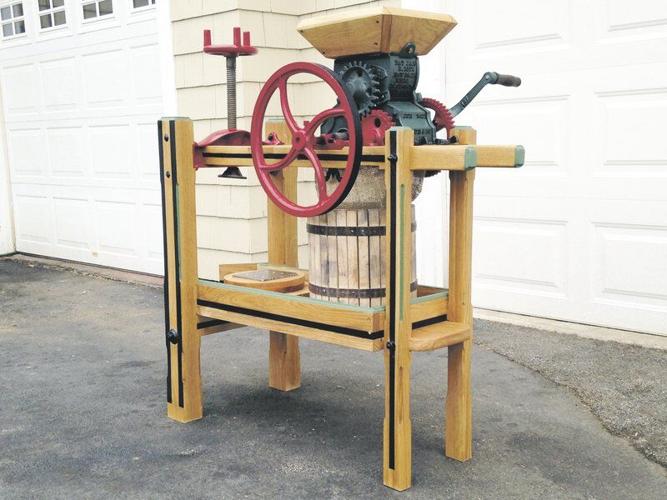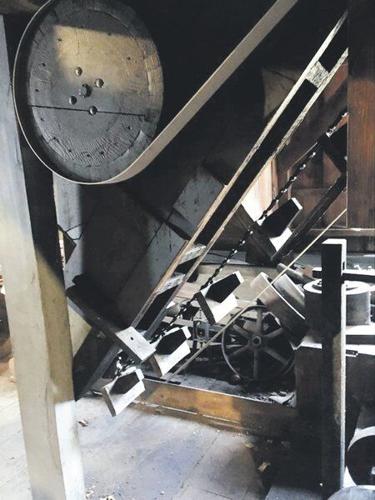It’s cider season and, for small-time area cider makers, and pressing is a sweet activity that helps preserve the past.
According to a recent Old Farmer’s Almanac article, “the ‘old-fashioned’ cider press is becoming more popular” and pickyourown.org puts New York state second among the nation’s top five cider-producing states, after Washington, but ahead of Michigan, Pennsylvania and California.
Burr Hubbell, of Hubbell Family Farms in Margaretville, remembers ladling scoops of sweet cider to patrons from stoneware jugs in the cellar of his family’s 1848 farm. Today, Hubbell spends Saturdays in autumn pressing apples on the family’s 1870 cider mill, what he called the largest continuously operating of its kind in the region.
“We usually start the last weekend in September and go through the first weekend in November,” Hubbell said. “The mill we have here was a commercial cider mill, designed for pressing cider in quantities for retail sale and as a service to area farmers.
“That’s actually what we do now, is just custom pressing,” he continued. “We press by appointment on Saturdays, so it’s more limited than in the past. Back in the day, we would’ve spent two or three weekdays pressing during cider season, and on those days, there would’ve been a line of wagons or pickup trucks full of feed bags and milk cans out to the highway … and up to the third story. We’d press their apples and then sell them the juice.”
A pressing, he said, takes about 45 minutes, with appointments made in half-hour slots. The family has offered by-appointment pressings, Hubbell said, since the mid-1990s, when New York state regulations began requiring that commercially produced apple cider be irradiated, a measure he said was cost-prohibitive.
Hubbell said the press, a fin-de-siècle Boomer and Boschert colossus manufactured primarily in Syracuse, is made for heavy pressing.
“The whole thing is powered from a single-cylinder gasoline engine (added in 1918) and line shafts and pulleys and belts. There’s lots of whirring machinery; it’s a Rube Goldberg kind of contraption and just fascinating to watch,” he said. “We load the apples in, the elevators take them to the hopper, the hopper sits over top of a grinder which grinds the apples, then they go down to the second floor to the pressing room. (There), they get laid out on a cloth that holds about five bushels each and we can put up to eight layers of cloth on the press on one side, so we can press around 40 to 50 bushels of apples on a side. The press is like a giant table … and it’s a screw press, or a jointed-arm press, so the screw brings the arms together and forces 150 tons of pressure on the apples and squeezes the juice out of the holes in the cloth and the cloth holds in the pomace (or apple mash).
“Each bushel of pressed apples yields somewhere between two and four gallons,” Hubbell said. “The typical batches we do these days are five or 10 bushels; we don’t typically see a 40- or 50-bushel job.”
A bushel, Hubbell said, is about two pecks and a peck is “about five gallons,” making a bushel of apples roughly equivalent to two five-gallon buckets’ worth. Hubbell said while annual yields are impacted by apple crops, he usually presses between 1,000 and 2,000 gallons a year.
And when pressing, Hubbell said, there’s no need to be picky.
“We’ll ground up any kind of apples; we’ve even done pears before,” he said. “A lot of people gather field apples or wild apples and bring those in and have them ground up. Some of the apples that don’t taste good, make good cider.
“It just depends on what flavors appeal to (customers) and their palate,” Hubbell continued. “And if you talk to people who make hard ciders, there are different things you want to look for, (such as) tannins and the acidity of the apple, because it gives a different structure, but we take almost any kind of apple we can get to make our own cider and throw it in the barrel with some sugar.”
“You can use all those less-than-perfect apples from the ground, so (making cider) is also a big savings from the price of store cider,” the Old Farmers’ Almanac article echoes.
It’s important to note that the passage of the Farm Cidery Law in 2016 helped spur hard cider’s increasing American popularity, with a 2018 Cornell Cooperative Extension report calling hard cider “one of the fastest-growing adult beverage (industries) in the country.” The report estimated “nearly 100 cider producers,” or “11% of the total number or producers in the country,” statewide at that time, with more than $1.3 billion in retail sales in 2017.
Like cider-worthy apple varieties, Hubbell said, customers are also diverse.
“Some (customers) are old farm families that remember having done this years ago that still want to come and want their grandchildren to see what we do,” he said. “We get local people that have always had their cider pressed here and, occasionally, we’ll get second homeowners or visitors that will go out and buy apples just for the experience of seeing their own cider pressed.”
For Unadilla resident and hobbyist cider-maker Jeff Held, that experience is at the core of what keeps him pressing. Together with his wife, Lisa, Held bought a used 1870s Whitman’s Jr. manual press in New England after seeing it listed online “six or seven years ago.”
“We only do it for ourselves, but we do set up (our press) whenever there’s the (Unadilla Rotary) Autumn Fest,” he said. “The whole idea is to let people see how apples were pressed in the old days and we try to get kids involved and they enjoy it. When they’ve ground up the apples and pressed them, they get to taste it and we get to say, ‘You made that, you did that.’
“If you go to a New York City school and ask a kid where milk or cider comes from … a lot of people just don’t realize the evolution of these things,” Held continued. “To us, the reason we love doing this is when kids and even adults get to see a product from start to finish, and it tastes better when you do it yourself.”
Held, who owns four presses, said pressing pairs craft with nostalgia.
“My wife and I grew up in the Walton area and both of our families used to pick apples — almost every family did this — and there was a place you could take your apples in a big old feed sack and drop them off and a guy would put everyone’s apples together and you’d get an amount of cider back. We kind of liked that and reminisced, then we saw (the press) listed on eBay or Craig’s List and … we reached out.”
Held, who said his Whitman’s press was “really rough” upon purchasing, painstakingly restored his machine.
“We did research and, it turns out, they used a white oak,” he said. “So, we searched and found a company and ordered the wood and … replaced everything. I cut it and shaved it exactly how it was on the original, so it would be a true restoration.”
In its day, Held said, the press likely would’ve served several families or a community.
“Essentially, this is what most individual families would have had. Families would get these and the neighbors would come around, and they’d work as a team,” he said. “It’s something maybe you’d find at a general store or something like that, and people would just go down and … barter and you’d get your apples done.”
Like Hubbell, Held said he’ll press just about anything.
“You try to get a juicier apple, but you can throw any apples in there,” he said. “Some people make hard cider from regular cider, and some make apple cider vinegar, it just depends on what you want to do. We try to do it once (each fall) and we grind whatever we can get our hands on and it still tastes pretty darn good.” Held said he hopes to produce “five or six gallons” this season.
Held and Hubbell said their labors have yielded more than just cider.
“It is hard work,” Held said, “but it’s a connection to our past. It’s kind a throwback. We got this because it was a neat little connection and we enjoy keeping that connection alive for ourselves and sharing it with people that are interested.”
“We do it mostly at this point because it’s a way of preserving family tradition and it’s a bit of history,” Hubbell said. “We don’t make any money on this; it’s a labor of love for about six weeks … but it’s a lot of fun just to run an old mill like this.”
For more information on cider makers and sellers, visit nycider.com. To schedule a pressing appointment with Hubbell, find “Hubbell Family Farm” on Facebook or visit hubbellfamilyfarms.com.














Commented
Sorry, there are no recent results for popular commented articles.